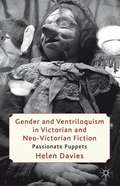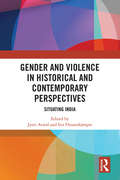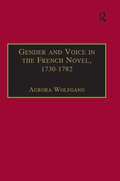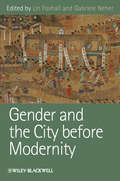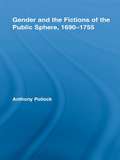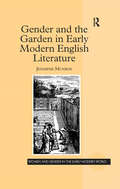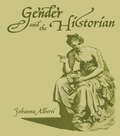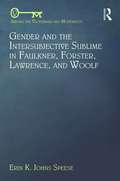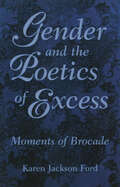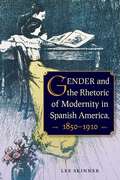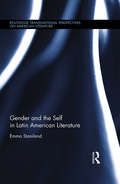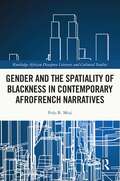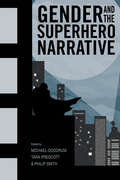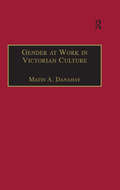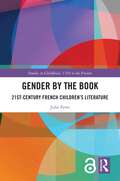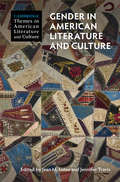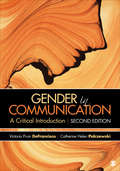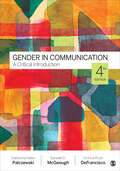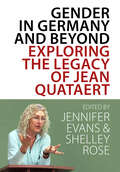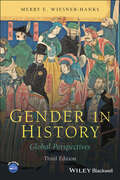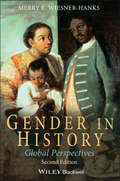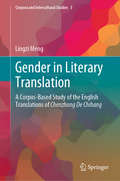- Table View
- List View
Gender and Ventriloquism in Victorian and Neo-Victorian Fiction
by Helen DaviesIn what ways does neo-Victorian fiction 'talk back' to the nineteenth century? What is at stake in the contemporary interest in 're-voicing' the Victorian era? Gender and Ventriloquism in Victorian and Neo-Victorian Fiction is the first book-length study of the relationship between ventriloquism and gender in nineteenth-century and contemporary literature set in the Victorian period. Offering an insight into the gendered history of ventriloquial utterance, this monograph seeks to re-evaluate the concept of ventriloquism by challenging the power relationship between 'ventriloquists' and 'dummies'. The ventriloquial metaphor articulates an ambivalent exchange between imitation and alteration, tribute and critique, voicing and silencing. Through detailed analysis of Victorian and neo-Victorian narratives of ventriloquism, Helen Davies locates ventriloquism as a key trope for exploring the politics of contemporary fiction's dialogues with the nineteenth century.
Gender and Violence in Historical and Contemporary Perspectives: Situating India
by Jyoti Atwal Iris FlessenkämperThis book covers a range of issues and phenomena around gender-related violence in specific cultural and regional conditions. Using an interdisciplinary approach, it discusses historical and contemporary developments that trigger violence while highlighting the social conditions, practices, discourses, and cultural experiences of gender-related violence in India. Beginning with the issues of gender-based violence within the traditional context of Indian history and colonial encounters, it moves on to explore the connections between gender, minorities, marginalisation, sexuality, and violence, especially violence against Dalit women, disabled women, and transgender people. It traces and interprets similarities and differences as well as identifies social causes of potential conflicts. Further, it investigates the forms and mechanisms of political, economic, and institutional violence in the legitimation or de-legitimation of traditional gender roles. The chapters deal with sexual violence, violence within marriage and family, influence of patriarchal forces within factory-based gender violence, and global processes such as demand-driven surrogacy and the politics of literary and cinematic representations of gender-based violence. The book situates relevant debates about India and underlines the global context in the making of the gender bias that leads to violence both in the public and private domains. An important contribution to feminist scholarship, this book will be useful to scholars and researchers of gender studies, women’s studies, history, sociology, and political science.
Gender and Voice in the French Novel, 1730–1782
by Aurora WolfgangAnalyzing four best-selling novels - by both women and men - written in the feminine voice, this book traces how the creation of women-centered salons and the emergence of a feminine poetic style engendered a new type of literature in eighteenth-century France. The author argues that writing in a female voice allowed writers of both sexes to break with classical notions of literature and style, so that they could create a modern sensibility that appealed to a larger reading public, and gave them scope to innovate with style and form. Wolfgang brings to light how the 'female voice' in literature came to embody the language of sociability, but also allowed writers to explore the domain of inter-subjectivity, while creating new bonds between writers and the reading public. Through examination of Marivaux's La Vie de Marianne, Graffigny's Lettres d'une Péruvienne, Riccoboni's Lettres de Mistriss Fanni Butlerd, and Laclos's Les Liaisons dangereuses, she shows that in France, this modern 'feminine' sensibility turned the least prestigious of literary genres - the novel - into the most compelling and innovative literary form of the eighteenth century. Emphasizing how the narratives analyzed here refashioned the French literary world through their linguistic innovation and expression of new forms of subjectivity, this study claims an important role for feminine-voice narratives in shaping the field of eighteenth-century literature.
Gender and the City before Modernity (Gender and History Special Issues #13)
by Lin Foxhall Gabriele NeherGender and the City before Modernity presents a series of multi-disciplinary readings that explore issues relating to the role of gender in a variety of cities of the ancient, medieval, and early modern worlds. Presents an inter-disciplinary collection of readings that reveal new insights into the intersection of gender, temporality, and urban space Features a wide geographical and methodological range Includes numerous illustrations to enhance clarity
Gender and the Fictions of the Public Sphere, 1690-1755 (Routledge Studies in Eighteenth-Century Literature #Vol. 4)
by Anthony PollockChallenging the longstanding interpretation of the early English public sphere as polite, inclusive, and egalitarian this book re-interprets key texts by representative male authors from the period—Addison, Steele, Shaftesbury, and Richardson—as reactionary responses to the widely-consumed and surprisingly subversive work of women writers such as Mary Astell, Delarivier Manley, and Eliza Haywood, whose political and journalistic texts have up until now received little scholarly consideration. By analyzing a wide range of materials produced between the 1690s to the 1750s, Pollock exposes a literary marketplace characterized less by cool rational discourse and genial consensus than by vehement contestation and struggles for cultural authority, particularly in debates concerning the proper extent of women’s participation in English public life. Utilizing innovative methods of research and analysis the book reveals that even at its moment of inception, there was an immanent critique of the early liberal public sphere being articulated by women writers who were keenly aware of the hierarchies and techniques of exclusion that contradicted their culture’s oft-repeated appeals to the principles of equality and universality.
Gender and the Garden in Early Modern English Literature (Women and Gender in the Early Modern World)
by Jennifer MunroeRadical reconfigurations in gardening practice in sixteenth- and seventeenth-century England altered the social function of the garden, offering men and women new opportunities for social mobility. While recent work has addressed how middle class men used the garden to attain this mobility, the gendering of the garden during the period has gone largely unexamined. This new study focuses on the developing gendered tension in gardening that stemmed from a shift from the garden as a means of feeding a family, to the garden as an aesthetic object imbued with status. The first part of the book focuses on how practical gardening books proposed methods for planting as they simultaneously represented gardens increasingly hierarchized by gender. The second part of the book looks at how men and women appropriated aesthetic uses of actual gardening in their poetry, and reveals a parallel gendered tension there. Munroe analyzes garden representations in the writings of such manuals writers as Gervase Markham, Thomas Hill, and William Lawson, and such poets as Edmund Spenser, Aemilia Lanyer and Lady Mary Wroth. Investigating gardens, gender and writing, Jennifer Munroe considers not only published literary representations of gardens, but also actual garden landscapes and unpublished evidence of everyday gardening practice. She de-prioritizes the text as a primary means of cultural production, showing instead the relationship between what men and women might imagine possible and represent in their writing, and everyday spatial practices and the spaces men and women occupied and made. In so doing, she also broadens our outlook on whom we can identify and value as producers of early modern social space.
Gender and the Historian (Making History)
by Johanna AlbertiWhy are most famous historians men? How have women changed the writing of history over the last decades? What lives and stories have been hidden from history? Until recently history was predominantly the domain of men. That men were the authors of our past meant that in many cases only half of the story was told. In the second half of the twentieth century, however, the picture changed. Women, and indeed some men as well, started to address gender history. Women had been investigated historically before, but never with such intensity, nor such breadth. The impetus for this writing was both political and academic as feminists were determined to explore lives which until then had been disregarded. Gender and the Historian charts the entry and development of this new history, showing how such considerations furthered postmodernism and ultimately reinvigorated the very core of History..
Gender and the Intersubjective Sublime in Faulkner, Forster, Lawrence, and Woolf (Among the Victorians and Modernists)
by Erin SpeeseExploring how the modern novel's complex depictions of parenthood restructure traditional conceptions of the Romantic sublime, Erin K. Johns Speese shows how William Faulkner, E.M. Forster, D.H. Lawrence, and Virginia Woolf use related strategies to rewrite the traditional sublime as an intersubjective experience. Speese shows that this reframing depends on the recognition of social objectification and an ethics of reciprocal empathy between mothers and fathers. She juxtaposes traditional aesthetics and Slavoj Žižek’s concept of the sublime object of ideology with recent theoretical work regarding identity, arguing that these modern novelists construct what she terms a "sublime subject," that is, a person who functions in the space of the traditional sublime object. In revealing the possibility of transcendent emotional connection over reason, these novelists critique the objectification of the other in favor of a sublime experience that reveals the subject-shattering power of empathy.
Gender and the Poetics of Excess: Moments of Brocade
by Karen Jackson FordThe argument posed in this analysis is that the poetic excesses of several major female poets, excesses that have been typically regarded as flaws in their work, are strategies for escaping the inhibiting and sometimes inimical conventions too often imposed on women writers. The forms of excess vary with each poet, but by conceiving of poetic excess in relation to literary decorum, this study establishes a shared motivation for such a strategy. Literary decorum is one instrument a culture employs to constrain its writers. Perhaps it is the most effective because it is the least definable. The excesses discussed here, like the criteria of decorum against which they are perceived, cannot be itemized as an immutable set of traits. Though decorum and excess shift over time and in different cultures, their relationship to one another remains strikingly stable. Thus, nineteenth-century standards for women's writing and late twentieth-century standards bear almost no relation. Emily Dickinson's do not anticipate Gertrude Stein's or Sylvia Plath's or Ntozake Shange's. Yet the charges of indecorousness leveled at these women poets repeat a fixed set of abstract grievances. Dickinson, Stein, Plath, Jayne Cortez, and Shange all engage in a poetics of excess as a means of rejecting the limitations and conventions of “female writing” that the larger culture imposes on them. In resisting conventions for feminine writing, these poets developed radical new poetries, yet their work was typically criticized or dismissed as excessive. Thus, Dickinson's form is classified as hysterical, and her figures tortured. Stein's works are called repetitive and nonsensical. Plath's tone is accused of being at once virulent and confessional, Cortez's poems violent and vulgar, Shange's work vengeful and self-righteous. The publishing history of these poets demonstrates both the opposition to such an aesthetic and the necessity for it.
Gender and the Rhetoric of Modernity in Spanish America, 1850–1910
by Lee SkinnerThis ambitious volume shows how nineteenth-century Spanish American writers used the discourses of modernity to envision the place of women at all levels of social and even political life in the modern, utopian nation. Looking at texts ranging from novels and essays to newspaper articles and advertisements, and with special attention to public and private space, domesticity, education, technology, and work, Skinner identifies gender as a central concern at every level of society.
Gender and the Self in Latin American Literature (Routledge Transnational Perspectives on American Literature)
by Emma StanilandThis book explores six texts from across Spanish America in which the coming-of-age story ('Bildungsroman') offers a critique of gendered selfhood as experienced in the region’s socio-cultural contexts. Looking at a range of novels from the late twentieth century, Staniland explores thematic concerns in terms of their role in elucidating a literary journey towards agency: that is, towards the articulation of a socially and personally viable female gendered identity, mindful of both the hegemonic discourses that constrain it, and the possibility of their deconstruction and reconfiguration. Myth, exile and the female body are the three central themes for understanding the personal, social and political aims of the Post-Boom women writers whose work is explored in this volume: Isabel Allende, Laura Esquivel, Ángeles Mastretta, Sylvia Molloy, Cristina Peri Rossi and Zoé Valdés. Their adoption, and adaptation, of an originally eighteenth-century and European literary genre is seen here to reshape the global canon as much as it works to reshape our understanding of gendered identities as socially constructed, culturally contingent, and open-ended.
Gender and the Spatiality of Blackness in Contemporary AfroFrench Narratives (Routledge African Diaspora Literary and Cultural Studies)
by Polo B. MojiThis book approaches the study of AfroEurope through narrative forms produced in contemporary France, a location which richly illustrates race in European spaces. The book adopts a transdiciplinary lens that combines critical black and urban geographies, intersectional feminism, and textual analysis to explore the spatial negotiations of black women in France. It assesses literature, film, and music as narrative forms and engages with the sociocultural and political contexts from which they emerge. Through the figure of the black flâneuse and the analytical framework of "walking as method", the book goes beneath spectacular representations of ghettoised banlieues, televised protests, and shipwrecked migrants to analyse the spatiality of blackness in the everyday. It argues that the material-discursive framing of black flânerie, as both relational and embodied movements, renders visible a politics of place embedded in everyday mico-struggles of raced-sexed subjects. Foregrounding expressive modes and forms that have traditionally received little critical attention outside of the French and francophone world, this book will be relevant to academics, researchers, writers, students, activists, and readers with interests in Literary and Cultural Studies, African and Afrodiasporic Studies, Black Feminisms, Migration Studies, Critical Black Geographies, Francophone Studies, and the comparative framework of Afroeuropean Studies.
Gender and the Superhero Narrative
by Michael Goodrum, Tara Prescott & Philip SmithContributions by Dorian L. Alexander, Janine Coleman, Gabriel Gianola, Mel Gibson, Michael Goodrum, Tim Hanley, Vanessa Hemovich, Christina Knopf, Christopher McGunnigle, Samira Nadkarni, Ryan North, Lisa Perdigao, Tara Prescott-Johnson, Philip Smith, and Maite Ucaregui The explosive popularity of San Diego’s Comic-Con, Star Wars: The Force Awakens and Rogue One, and Netflix’s Jessica Jones and Luke Cage all signal the tidal change in superhero narratives and mainstreaming of what were once considered niche interests. Yet just as these areas have become more openly inclusive to an audience beyond heterosexual white men, there has also been an intense backlash, most famously in 2015’s Gamergate controversy, when the tension between feminist bloggers, misogynistic gamers, and internet journalists came to a head. The place for gender in superhero narratives now represents a sort of battleground, with important changes in the industry at stake. These seismic shifts—both in the creation of superhero media and in their critical and reader reception—need reassessment not only of the role of women in comics, but also of how American society conceives of masculinity. Gender and the Superhero Narrative launches ten essays that explore the point where social justice meets the Justice League. Ranging from comics such as Ms. Marvel, Batwoman: Elegy, and Bitch Planet to video games, Netflix, and cosplay, this volume builds a platform for important voices in comics research, engaging with controversy and community to provide deeper insight and thus inspire change.
Gender at Work in Victorian Culture: Literature, Art and Masculinity (The Nineteenth Century Series)
by Martin A. DanahayMartin A. Danahay's lucidly argued and accessibly written volume offers a solid introduction to important issues surrounding the definition and division of labor in British society and culture. 'Work,' Danahay argues, was a term rife with ideological contradictions for Victorian males during a period when it was considered synonymous with masculinity. Male writers and artists in particular found their labors troubled by class and gender ideologies that idealized 'man's work' as sweaty, muscled labor and tended to feminize intellectual and artistic pursuits. Though many romanticized working-class labor, the fissured representation of the masculine body occasioned by the distinction between manual labor and 'brain work' made it impossible for them to overcome the Victorian class hierarchy of labor. Through cultural studies analyses of the novels of Dickens and Gissing; the nonfiction prose of Carlyle, Ruskin and Morris; the poetry of Thomas Hood; paintings by Richard Redgrave, William Bell Scott, and Ford Madox Brown; and contemporary photographs, including many from the Munby Collection, Danahay examines the ideological contradictions in Victorian representations of men at work. His book will be a valuable resource for scholars and students of English literature, history, and gender studies.
Gender by the Book: 21st-Century French Children's Literature (Studies in Childhood, 1700 to the Present)
by Julie FetteGender by the Book investigates the gender representations that French children's literature transmits to readers today. Using an interdisciplinary, mixed methods approach, this book grounds its literary analysis in a sociohistorical examination of three key institutions – libraries, book clubs, and subscription magazines – that circulate reading material to children. It shows how French policies, cultural beliefs, and market forces influence the content of children's literature, including tensions between State support for unprofitable artistic endeavors and a belief in children’s right to high-quality products on the one hand, and suspicion of activism as anathema to creativity and fear of losing boy readers on the other. In addition, the notion of universalism, which asserts that equality is best achieved when society is blind to differences, thwarts a diverse and equitable array of literary representations. Nevertheless, conditions are favorable for 21st-century French children's publishers to offer a robust body of richly entertaining egalitarian literature for children.This title is freely available as open access thanks to generous support from the Fondren Library at Rice University.
Gender in American Literature and Culture (Cambridge Themes in American Literature and Culture)
by Jennifer Travis Jean M. LutesGender in American Literature and Culture introduces readers to key developments in gender studies and American literary criticism. It offers nuanced readings of literary conventions and genres from early American writings to the present and moves beyond inflexible categories of masculinity and femininity that have reinforced misleading assumptions about public and private spaces, domesticity, individualism, and community. The book also demonstrates how rigid inscriptions of gender have perpetuated a legacy of violence and exclusion in the United States. Responding to a sense of 21st century cultural and political crisis, it illuminates the literary histories and cultural imaginaries that have set the stage for urgent contemporary debates.
Gender in Communication: A Critical Introduction
by Victoria Pruin Defrancisco Catherine H. Palczewski Danielle McgeoughGender in Communication: A Critical Introduction, Second Edition examines the variety of ways in which communication of and about gender enables and constrains people’s identities. Authors Catherine Helen Palczewski and Victoria Pruin DeFrancisco, with Danielle Dick McGeough, demonstrate how communication constitutes gender, rather than presenting gender as an influence on communication. Operating from an intersectional gender diversity perspective, they show how a focus on gender/sex alone omits the richness of diverse gendered lives. In addition, they explore how gender is constructed through interpersonal and public discourse in, about, and by the social institutions of family, education, work, religion, and media. Throughout the book, readers are equipped with critical analysis tools they can use to form their own conclusions about the ever-changing processes of gender in communication.
Gender in Communication: A Critical Introduction
by Catherine H. Palczewski Victoria Pruin DeFrancisco Danielle McGeoughGender in Communication: A Critical Introduction embraces the full range of diverse gender identities and expressions to explore how gender influences communication, as well as how communication shapes our concepts of gender for the individual and for society. This comprehensive gender communication book is the first to extensively address the roles of religion, the gendered body, single-sex education, an institutional analysis of gender construction, social construction theory, and more. Throughout the book, you are equipped with critical analysis tools you can use to form your own conclusions about the ever-changing processes of gender in communication. New to the Third Edition: Current examples in the chapter openers illustrate how a critical gendered lens is necessary and useful by discussing recent events, such as Jon Stewart’s critique of the outcry over a J. Crew ad, reactions to Serena Williams’s body, photos of a young boy who likes to wear dresses, and the use of Photoshop to create thigh gaps. Updated chapters on voices, work, education, and family reflect major shifts in the state of knowledge. Expanded sections on trans and gender non-conforming identities reflect changes in language. All other chapters have been updated with new examples, new concepts, and new research. More than 500 new sources have been integrated throughout, and new sections on debates over bathroom bills, intensive mothering, humor, swearing, and Title IX have been added. “His” and “her” pronouns have been replaced with “they” in most cases, even if the reference is singular, in an effort to be more inclusive.
Gender in Communication: A Critical Introduction
by Catherine H. Palczewski Victoria Pruin DeFrancisco Danielle McGeoughGender in Communication: A Critical Introduction embraces the full range of diverse gender identities and expressions to explore how gender influences communication, as well as how communication shapes our concepts of gender for the individual and for society. This comprehensive gender communication book is the first to extensively address the roles of religion, the gendered body, single-sex education, an institutional analysis of gender construction, social construction theory, and more. Throughout the book, you are equipped with critical analysis tools you can use to form your own conclusions about the ever-changing processes of gender in communication. New to the Third Edition: Current examples in the chapter openers illustrate how a critical gendered lens is necessary and useful by discussing recent events, such as Jon Stewart’s critique of the outcry over a J. Crew ad, reactions to Serena Williams’s body, photos of a young boy who likes to wear dresses, and the use of Photoshop to create thigh gaps. Updated chapters on voices, work, education, and family reflect major shifts in the state of knowledge. Expanded sections on trans and gender non-conforming identities reflect changes in language. All other chapters have been updated with new examples, new concepts, and new research. More than 500 new sources have been integrated throughout, and new sections on debates over bathroom bills, intensive mothering, humor, swearing, and Title IX have been added. “His” and “her” pronouns have been replaced with “they” in most cases, even if the reference is singular, in an effort to be more inclusive.
Gender in Communication: A Critical Introduction
by Catherine H. Palczewski Victoria Pruin DeFrancisco Danielle McGeoughGender in Communication: A Critical Introduction embraces the full range of diverse gender identities and expressions to explore how gender influences communication, as well as how communication shapes our concepts of gender for the individual and for society at large. Authors Catherine Helen Palczewski, Danielle D. McGeough, and Victoria Pruin DeFrancisco equip readers with the critical analysis tools to form their own conclusions about the ever changing processes of gender in communication. This comprehensive gender communication book is the first to extensively address the roles of religion, the gendered body, single-sex education, an institutional analysis of gender construction, social construction theory, and more. The Fourth Edition has streamlined the text to make it more accessible to students without sacrificing the sophistication of the book′s trademark intersectional approach.
Gender in Communication: A Critical Introduction
by Catherine H. Palczewski Victoria Pruin DeFrancisco Danielle McGeoughGender in Communication: A Critical Introduction embraces the full range of diverse gender identities and expressions to explore how gender influences communication, as well as how communication shapes our concepts of gender for the individual and for society at large. Authors Catherine Helen Palczewski, Danielle D. McGeough, and Victoria Pruin DeFrancisco equip readers with the critical analysis tools to form their own conclusions about the ever changing processes of gender in communication. This comprehensive gender communication book is the first to extensively address the roles of religion, the gendered body, single-sex education, an institutional analysis of gender construction, social construction theory, and more. The Fourth Edition has streamlined the text to make it more accessible to students without sacrificing the sophistication of the book′s trademark intersectional approach.
Gender in Germany and Beyond: Exploring the Legacy of Jean Quataert
by Jennifer V. Evans and Shelley E. RoseJean Quataert redefined the boundaries of at least five historical fields including European socialism, women’s history and gender history, and international law and human rights. In this volume dedicated to her pioneering work, established and emerging scholars showcase the signature ways in which Quataert, as one of the discipline’s first women’s historians, has influenced how subsequent generations think about history writing as a form of intellectual activism. Gender in Germany and Beyond presents cutting edge historiographical commentary alongside new work which address subjects such as the history of German colonialism and women’s colonial leagues, human rights advocacy during the Cold War, and the complexities of turn of the century gay and lesbian rights organizing.
Gender in History: Global Perspectives (Design Principles For Teaching History Ser.)
by Merry E. Wiesner-HanksA concise yet comprehensive account of the roles and influences of gender over the millennia, featuring new and updated content throughout Gender in History: Global Perspectives, Third Edition, explores the construction and evolution of gender in many of the world’s cultures from the Paleolithic era to the COVID pandemic of the twenty-first century. Broad in geographic and topical scope, this comprehensive volume discusses the ways families, religions, social hierarchies, politics, work, education, art, sexuality, and other issues are linked to various conceptions of gender. Now organized chronologically rather than topically, this extensively revised edition presents a wealth of up-to-date information based on the scholarship of the last decade. New and expanded chapters offer insights on the connections between gender and key events and trends in world history, including domestication and the development of agriculture, the growth of cities and larger-scale political structures, the spread of world religions, changing ideas of race, class, and sexuality, colonialism and imperialism, capitalism, wars, revolutions, and more. Written by a distinguished scholar in the field of women's and gender history, this third edition of Gender in History: Examines how gender roles were shaped by family life, religious traditions, various other institutions, and how the institutions were influenced by gender Considers why gender variations developed in different cultures and in diverse social, ethnic, and racial groups within a single culture Addresses ideas in different cultures that shaped both informal societal norms and formalized laws Explores debates about the origins of patriarchy, the development of complex gender hierarchies, and contemporary movements for social change Discusses the gender implications of modern issues including the global pandemic and ongoing cultural and economic shifts Includes an accessible introduction to key theoretical and methodological issues and an instructor’s website site with visual and written original sources Gender in History: Global Perspectives, Third Edition, is essential reading for undergraduate and graduate students in courses such as those on women’s history, women in world history, and gender in world history, and a valuable supplement for general survey courses within History and Women’s and Gender Studies programs.
Gender in History: Global Perspectives (New Perspectives On The Past Ser. #41)
by Merry E. Wiesner-HanksUpdated with new material to reflect the latest developments in the field, Gender in History: Global Perspectives, 2nd Edition, provides a concise overview of the construction of gender in world cultures from the Paleolithic era to modern times. Includes examples drawn from the most recent scholarship relating to a diverse range of cultures, from Ancient Mesopotamia to post-Soviet Russia, and from the Igbo of Nigeria, to the Iroquois of north eastern North America. Reflects new developments in the field with added coverage of primates, slavery, colonialism, masculinity, and transgender issues Features significant discussion of the Paleolithic and Neolithic periods, an important trend in the study of world history Lays out key theoretical and methodological issues in an introduction that is written in accessible language Supplementary material for instructors and students available at www.wiley.com/go/wiesnerhanks
Gender in Literary Translation: A Corpus-based Study Of The English Translations Of Chenzhong De Chibang (Corpora and Intercultural Studies #3)
by Lingzi MengThis book explores the role of gender in male- and female-produced efforts to translate a Chinese novel into English. Adopting the CDA framework and corpus methodology, the study examines the specific ways in which, and extent to which, a female British translator and a male American translator construct their gender identity in translation. Based on an analysis of the two translations’ textual and paratextual features, it reveals the fascinating ways in which language, gender and translation interact. The book is intended for anyone who is interested in gender and translation studies, particularly in applying the new corpus methodology to exploring the interface between gender and translation in the Chinese context.
